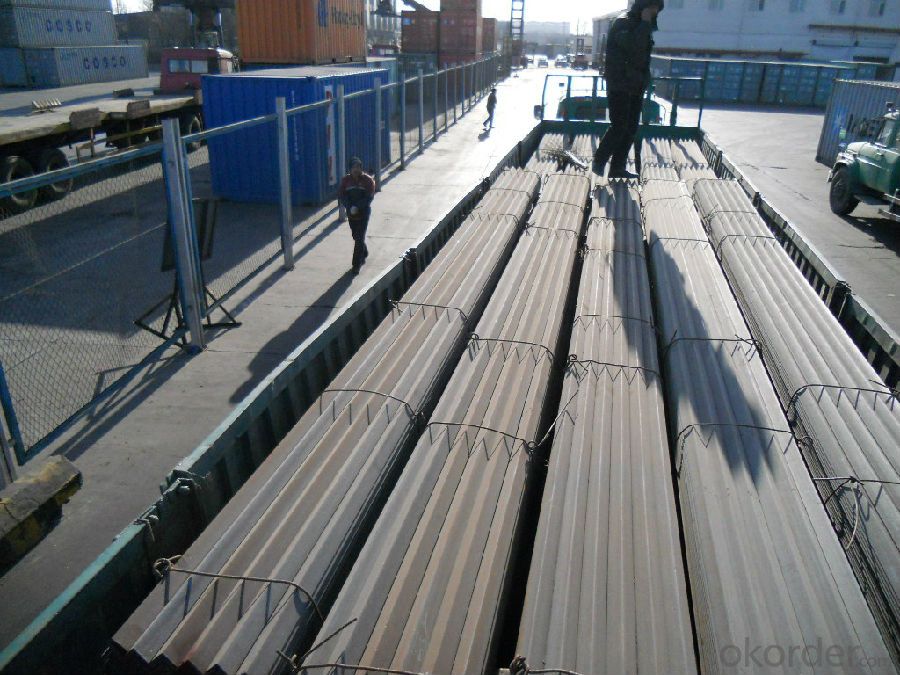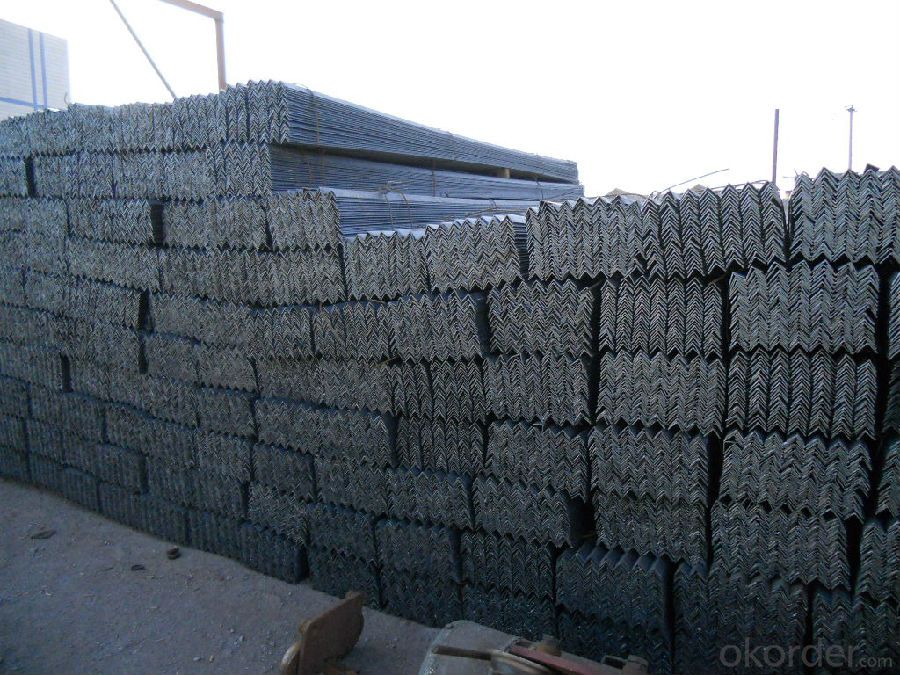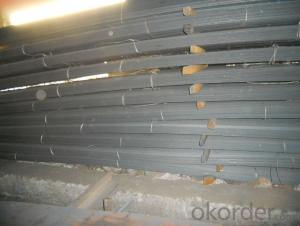Hot Rolled Equal Angle Steel with High Quality
- Loading Port:
- Tianjin
- Payment Terms:
- TT or LC
- Min Order Qty:
- 20 m.t.
- Supply Capability:
- 1000 m.t./month
OKorder Service Pledge
OKorder Financial Service
You Might Also Like
Product Description:
OKorder is offering Hot Rolled Carbon Steel Equal Angle at great prices with worldwide shipping. Our supplier is a world-class manufacturer of steel, with our products utilized the world over. OKorder annually supplies products to European, North American and Asian markets. We provide quotations within 24 hours of receiving an inquiry and guarantee competitive prices.
Product Applications:
According to the needs of different structures, Angle can compose to different force support component, and also can be the connections between components. It is widely used in various building structures and engineering structures such as roof beams, bridges, transmission towers, hoisting machinery and transport machinery, ships, industrial furnaces, reaction tower, container frame and warehouse etc.
Product Advantages:
OKorder's Equal Angle are durable, strong, and resist corrosion.
Main Product Features:
· Premium quality
· Prompt delivery & seaworthy packing (30 days after receiving deposit)
· Corrosion resistance
· Can be recycled and reused
· Mill test certification
· Professional Service
· Competitive pricing
Product Specifications:
1. Invoicing on theoretical weight or actual weight as customer request
2. Length: 6m, 9m, 12m as following table
3. Sizes

Sizes: 25mm-250mm | ||
a*t | ||
25*2.5-4.0 | 70*6.0-9.0 | 130*9.0-15 |
30*2.5-6.6 | 75*6.0-9.0 | 140*10-14 |
36*3.0-5.0 | 80*5.0-10 | 150*10-20 |
38*2.3-6.0 | 90*7.0-10 | 160*10-16 |
40*3.0-5.0 | 100*6.0-12 | 175*12-15 |
45*4.0-6.0 | 110*8.0-10 | 180*12-18 |
50*4.0-6.0 | 120*6.0-15 | 200*14-25 |
60*4.0-8.0 | 125*8.0-14 | 250*25 |
4. Payment terms:
1).100% irrevocable L/C at sight.
2).30% T/T prepaid and the balance against the copy of B/L.
3).30% T/T prepaid and the balance against L/C
5.Material details:
Alloy No | Grade | Element (%) | |||||
C | Mn | S | P | Si | |||
Q235 | B | 0.12—0.20 | 0.3—0.7 | ≤0.045 | ≤0.045 | ≤0.3 | |
Alloy No | Grade | Yielding strength point( Mpa) | |||||
Thickness (mm) | |||||||
≤16 | >16--40 | >40--60 | >60--100 | ||||
≥ | |||||||
Q235 | B | 235 | 225 | 215 | 205 | ||
Alloy No | Grade | Tensile strength (Mpa) | Elongation after fracture (%) | ||||
Thickness (mm) | |||||||
≤16 | >16--40 | >40--60 | >60--100 | ||||
≥ | |||||||
Q235 | B | 375--500 | 26 | 25 | 24 | 23 | |
FAQ:
Q1: Why buy Materials & Equipment from OKorder.com?
A1: All products offered byOKorder.com are carefully selected from China's most reliable manufacturing enterprises. Through its ISO certifications, OKorder.com adheres to the highest standards and a commitment to supply chain safety and customer satisfaction.
Q2: How do we guarantee the quality of our products?
A2: We have established an advanced quality management system which conducts strict quality tests at every step, from raw materials to the final product. At the same time, we provide extensive follow-up service assurances as required.
Q3: How soon can we receive the product after purchase?
A3: Within three days of placing an order, we will begin production. The specific shipping date is dependent upon international and government factors, but is typically 7 to 10 workdays.
Q4: What makes stainless steel stainless?
A4: Stainless steel must contain at least 10.5 % chromium. It is this element that reacts with the oxygen in the air to form a complex chrome-oxide surface layer that is invisible but strong enough to prevent further oxygen from "staining" (rusting) the surface. Higher levels of chromium and the addition of other alloying elements such as nickel and molybdenum enhance this surface layer and improve the corrosion resistance of the stainless material.


- Q:How do you cut steel angles?
- To cut steel angles, there are several methods you can use depending on the thickness and size of the angle. One common method is to use a metal cutting saw, such as a metal chop saw or a band saw. These saws are specifically designed to cut through metal and have the power and cutting capacity to handle steel angles. Before cutting, it is important to secure the steel angle firmly in place using clamps or a vice to prevent any movement during the cutting process. This will ensure accurate and clean cuts. It is also recommended to wear appropriate safety gear, including safety glasses and gloves, as cutting steel can produce sharp metal chips. If using a metal chop saw, you can adjust the angle on the saw to match the angle you need to cut. Make sure to set the blade speed and feed rate according to the manufacturer's recommendations for cutting steel. Slowly lower the blade onto the steel angle, applying steady pressure to achieve a smooth and precise cut. If a band saw is being used, ensure that the appropriate blade for cutting metal is installed. Adjust the blade tension and guide settings according to the manufacturer's instructions. Slowly feed the steel angle into the saw, maintaining a steady pace to achieve a clean cut. It is important to note that band saws may produce more heat during cutting, so periodically applying a coolant lubricant can help prevent overheating and extend the life of the blade. For thicker and larger steel angles, plasma cutting or oxy-fuel cutting methods can be utilized. These methods involve using high-temperature flames or a plasma arc to melt through the steel. However, they require specialized equipment and expertise to operate safely. Regardless of the cutting method used, it is crucial to measure and mark the desired cut line accurately before starting the cutting process. This will ensure that the steel angle is cut to the correct dimensions. Additionally, it is recommended to practice on scrap pieces of steel before attempting to cut the actual steel angle to gain familiarity with the cutting process and achieve the desired results.
- Q:How do you determine the appropriate thickness of a steel angle for a specific application?
- To determine the appropriate thickness of a steel angle for a specific application, several factors need to be considered. These factors include the load-bearing requirements, the length and span of the angle, and the structural design codes and standards applicable to the specific application. By evaluating these factors, engineers can calculate the required moment of inertia and bending capacity, allowing them to select the appropriate thickness of the steel angle that will provide sufficient strength and structural integrity for the intended use.
- Q:Can steel angles be used as bracing elements?
- Yes, steel angles can be used as bracing elements. Steel angles are often used in construction as bracing elements due to their strength and stability. They can effectively provide support and enhance the structural integrity of a building or structure.
- Q:Can steel angles be used for supports in bridges?
- Yes, steel angles can be used for supports in bridges. Steel angles are commonly used in bridge construction as they provide strength and stability. They are used as vertical supports, known as piers or columns, and as horizontal supports, known as beams or girders. Steel angles offer several advantages for bridge construction, including their high strength-to-weight ratio and their ability to withstand heavy loads and vibrations. They are also versatile and can be easily fabricated and connected, allowing for efficient and cost-effective bridge construction. Overall, steel angles are a popular choice for bridge supports due to their durability, reliability, and efficiency in supporting the weight and load of a bridge structure.
- Q:What are the advantages of using steel angles in manufacturing?
- There are several advantages of using steel angles in manufacturing. Firstly, steel angles provide excellent structural support and stability, making them ideal for various applications such as constructing buildings, bridges, and machinery. Secondly, steel angles have high tensile strength and durability, ensuring long-lasting and reliable performance. Additionally, steel angles are versatile and can be easily customized and fabricated to meet specific design requirements. Lastly, steel angles are cost-effective, readily available, and have a high recyclability rate, making them an environmentally-friendly choice for manufacturers.
- Q:Are there any specific design considerations when using steel angles?
- Yes, there are several specific design considerations when using steel angles. These include determining the appropriate size and thickness of the angle to ensure structural stability and load-bearing capacity, considering the angle's orientation and connection details for proper installation, and accounting for any potential deflection or buckling issues that may arise due to the long and slender nature of angles. Additionally, it is important to consider the corrosion resistance of steel angles in certain environments and to select the appropriate coatings or treatments to mitigate this potential issue.
- Q:What are the tolerance specifications for steel angles?
- The tolerance specifications for steel angles can differ based on various organizations and industries' specific standards and requirements. However, in general, the tolerance specifications for steel angles typically encompass measurements for dimensions like leg length, thickness, and straightness. Leg length tolerance ensures that the angle's legs are within an acceptable range of the desired measurement by allowing a certain deviation from the specified leg length. For instance, a tolerance specification of ±1/8 inch permits the leg length to deviate by up to 1/8 inch in either direction from the specified dimension. Thickness tolerance denotes the allowable deviation in the thickness of the steel angle. This specification guarantees consistency and adherence to an acceptable range of thickness. It is usually expressed as a percentage or an absolute value. For example, a tolerance specification of ±10% permits the thickness to deviate by up to 10% above or below the specified dimension. Straightness tolerance ensures that the steel angle is not bent or twisted and meets the required straightness criteria. It is commonly measured by the maximum allowable deviation from a straight line. This tolerance specification guarantees ease of fitting and alignment during construction or manufacturing processes. It is important to note that the specific tolerance specifications for steel angles may vary depending on the intended application, industry standards, and regulatory requirements. Therefore, it is recommended to consult the manufacturer, industry associations, or governing bodies for accurate and up-to-date information on the tolerance specifications for steel angles by referring to the relevant standards, codes, or specifications.
- Q:Can steel angles be used for manufacturing outdoor benches?
- Yes, steel angles can be used for manufacturing outdoor benches. Steel angles are strong and durable, making them suitable for outdoor use where the bench may be exposed to harsh weather conditions. Additionally, steel angles can be easily welded together to create a sturdy frame for the bench. The steel frame can then be paired with other materials such as wood or metal slats to form the seating surface. Overall, steel angles are a popular choice for manufacturing outdoor benches due to their strength, durability, and versatility.
- Q:What is the difference between equal and unequal steel angles?
- Equal steel angles have equal sides and angles, meaning they form right angles. Unequal steel angles, on the other hand, have different sides and angles, resulting in non-right angles.
- Q:Can steel angles be used for framing windows or doors?
- Yes, steel angles can be used for framing windows or doors. Steel angles are commonly used in construction for their strength and durability. They provide structural support and stability when used as framing material. Steel angles can be easily customized and cut to the desired length, making them suitable for framing windows and doors of various sizes. Additionally, steel angles can be welded or bolted together to create a sturdy frame that can withstand heavy loads and provide the necessary support for windows and doors.
1. Manufacturer Overview |
|
|---|---|
| Location | |
| Year Established | |
| Annual Output Value | |
| Main Markets | |
| Company Certifications | |
2. Manufacturer Certificates |
|
|---|---|
| a) Certification Name | |
| Range | |
| Reference | |
| Validity Period | |
3. Manufacturer Capability |
|
|---|---|
| a)Trade Capacity | |
| Nearest Port | |
| Export Percentage | |
| No.of Employees in Trade Department | |
| Language Spoken: | |
| b)Factory Information | |
| Factory Size: | |
| No. of Production Lines | |
| Contract Manufacturing | |
| Product Price Range | |
Send your message to us
Hot Rolled Equal Angle Steel with High Quality
- Loading Port:
- Tianjin
- Payment Terms:
- TT or LC
- Min Order Qty:
- 20 m.t.
- Supply Capability:
- 1000 m.t./month
OKorder Service Pledge
OKorder Financial Service
Similar products
New products
Hot products
Related keywords





























